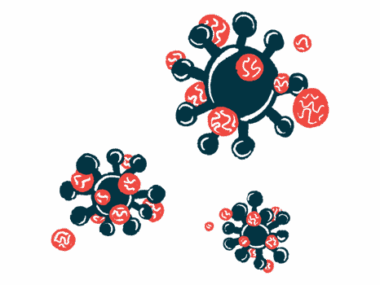Combo maintentance therapy found more effective in severe EGPA
Nucala plus azathioprine better than either treatment alone: Real-world study
Written by |

Combination maintenance therapy with Nucala (mepolizumab) and azathioprine may be more effective than either treatment alone at maintaining disease remission and reducing the need for glucocorticoids in people with severe eosinophilic granulomatosis with polyangiitis (EGPA).
These are the findings of a single-center study in Japan that support the use of a Nucala-azathioprine combo for maintenance treatment of severe EGPA, the rarest type of ANCA-associated vasculitis, or AAV.
While the study was small, involving a total of 40 patients, the researchers found that, “compared with the non-[combination treatment] group, at the last observation, the [combo therapy] group had a significantly higher remission rate,” the team wrote.
Further, six of 11 patients in the combo group were able to stop glucocorticoid use, compared with two of the 29 patients in the groups who did not receive both therapies.
“These results demonstrated the effectiveness of a combination … therapy in patients with EGPA,” the researchers wrote.
The study, “The effectiveness of combination maintenance therapy with mepolizumab and azathioprine for eosinophilic granulomatosis with polyangiitis,” was published as a letter to the editor in the International Journal of Rheumatic Diseases.
Standard EGPA treatment typically involves glucocorticoids
AAV comprises a group of conditions marked by inflammation of blood vessels of small and medium size that can result in damage to multiple organs. In EGPA, this is driven by eosinophil-rich granulomas, which are small clusters of a type of white blood cells called eosinophils.
Standard treatment usually involves high-dose glucocorticoids, a class of steroid hormones, with or without other immunosuppressive medications. However, despite the use of these treatments, many patients go through frequent cycles of remission and relapse, where periods of recovery are followed by a worsening of symptoms or the onset of new ones.
In addition, high doses and/or long-term treatment with glucocorticoids are associated with severe side effects.
GlaxoSmithKline’s Nucala, administered as subcutaneous or under-the-skin injections, is approved as an add-on therapy for certain EGPA patients in several regions, including the U.S. and the European Union. In Japan, the therapy was approved in 2018 for adults with EGPA patients who had inadequate responses to standard treatment.
Nucala works by blocking interleukin-5 (IL-5), a signaling molecule that acts on eosinophils, helping them grow in number, mature, and survive. By reducing the number of eosinophils in circulation, Nucala is expected to reduce blood vessel inflammation and damage, easing EGPA symptoms.
Clinical trial data showed that adding Nucala to standard AAV treatment helped adults with relapsing or treatment-resistant (refractory) EGPA achieve and stay in remission relative to those given a placebo in addition to standard medication.
Current guidelines recommend using Nucala to treat people with relapsing or refractory EGPA but with no organ- or life-threatening disease. Multiple real-world studies have shown that, over the long term, the therapy reduces disease activity and the risk of relapse, and prolongs survival.
“However, there are several unknowns regarding combination therapy in this population,” the researchers wrote.
Investigating maintenance therapy options for EGPA
To learn more, a team from the Juntendo University Hospital in Tokyo evaluated the effectiveness of combination maintenance treatment with Nucala plus azathioprine, an immunosuppressive treatment, for severe EGPA. Individuals with severe EGPA have organ- or life-threatening manifestations of the disease.
The researchers retrospectively analyzed data from the 28 women and 12 men in the study, who were treated at their hospital between November 2017 and December 2023. The patients had lived with the disease for a median of seven years — with a range of three to 15 years — and they were followed for a median of 84 months, or seven years.
A total of 11 patients, by their doctor’s decision, received treatment with Nucala plus azathioprine. The other 29 received either Nucala or azathioprine, alone or in combination with methotrexate, another immunosuppressive medication.
The main goal was to watch for differences in the proportion of patients who were in remission at their last assessment. Remission was defined as a Birmingham Vasculitis Activity Score (BVAS) of zero, indicating no disease activity, and receiving up to 4 mg per day of prednisolone or prednisone, two glucocorticoids.
The results showed that the proportion of patients who remained in remission at the last assessment was significantly higher among those treated with Nucala plus azathioprine than those receiving other regimens (91% vs. 31%).
Those on the Nucala-azathioprine combo also had significantly fewer eosinophils in circulation and used significantly lower daily glucocorticoid doses. Six patients treated with the combo (54.5%) were able to discontinue glucocorticoids, compared with two patients in the other treatment groups (6.9%).
[These findings] may indicate that [Nucala] and [azathioprine] comprise the optimal combination therapy in the maintenance treatment of EGPA.
The rate of disease remission among patients treated with Nucala plus azathioprine was also significantly higher than that observed for the 11 patients who received Nucala alone (91% vs. 36%). The combo maintenance therapy was also associated with significantly lower doses of glucocorticoids, and allowed one patient to discontinue glucocorticoids.
Moreover, the Nucala plus azathioprine combo was associated with the highest rate of remission relative to Nucala alone, azathioprine alone, and other treatment regimens.
These findings “may indicate that [Nucala] and [azathioprine] comprise the optimal combination therapy in the maintenance treatment of EGPA,” the researchers wrote.
While azathioprine was associated with adverse events that led to treatment discontinuation in three patients, no patient discontinued treatment with Nucala.
“The adverse events of [Nucala] were consistent with the known safety profile, but the physicians should more attend to adverse events for [Nucala] and [azathioprine] combination therapy,” the team wrote.
Because the study was done at a single center with a small number of patients, the researchers noted that future studies will be needed to confirm these findings. Such work should involve larger patient groups and additional immunosuppressants, the team noted.






